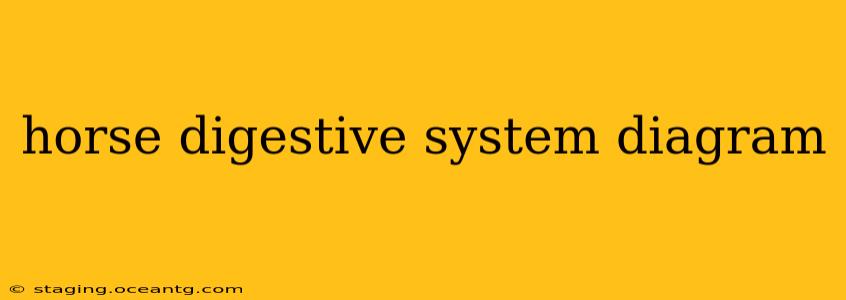Horses possess a unique digestive system, perfectly adapted for their evolutionary history as grazing animals. Unlike humans, who are omnivores, horses are hindgut fermenters, meaning the majority of their digestion occurs in the large intestine. This intricate system, however, is also sensitive and prone to problems if not properly managed. This comprehensive guide will delve into the various components of a horse's digestive system, answering common questions and highlighting crucial aspects of equine health.
What are the main parts of a horse's digestive system?
A horse's digestive system is comprised of several key organs, each playing a vital role in the breakdown and absorption of food. These include:
- Mouth: The process begins here, with the horse's teeth grinding food into smaller particles, mixing it with saliva. Saliva contains enzymes that initiate the breakdown of carbohydrates.
- Esophagus: A muscular tube that transports food from the mouth to the stomach. Horses are unable to regurgitate, a crucial point to remember in terms of their digestive health.
- Stomach: Relatively small in comparison to the overall digestive tract, the stomach primarily breaks down food using gastric acids and enzymes. This is where protein digestion begins.
- Small Intestine: Here, the majority of nutrient absorption occurs. The small intestine is responsible for absorbing amino acids, sugars, and fatty acids.
- Large Intestine (Cecum, Large Colon, Small Colon, Rectum): This is where the magic happens for hindgut fermenters like horses. The cecum, a large pouch, houses a vast population of microorganisms (bacteria, fungi, protozoa) that ferment fiber, breaking it down into volatile fatty acids (VFAs), which provide a significant source of energy for the horse. The large and small colons further process the remaining food, absorbing water and electrolytes. The rectum stores feces before elimination.
What is the function of the cecum in a horse's digestive system?
The cecum is a critical component of a horse's digestive system, playing a central role in fiber digestion. This large, pouch-like structure houses a complex microbial ecosystem that ferments the indigestible cellulose found in plant matter. This fermentation process produces volatile fatty acids (VFAs), the primary energy source for the horse. Without a properly functioning cecum, the horse would be unable to efficiently extract energy from its diet. Disruptions to the cecum's microbial balance, often due to diet changes or illness, can lead to digestive upset and colic.
How long does it take for food to pass through a horse's digestive system?
The transit time of food through a horse's digestive system varies depending on several factors, including the type of feed, the horse's health, and its activity level. However, a general estimate is that it takes approximately 36-72 hours for food to pass completely through the system. This lengthy process underscores the importance of providing consistent, high-quality feed and ensuring access to clean water.
What are some common digestive problems in horses?
Horses are susceptible to a range of digestive issues, many stemming from their unique physiology. Some common problems include:
- Colic: A general term for abdominal pain, colic can range from mild discomfort to a life-threatening emergency. Various factors, including dietary indiscretions, parasites, and intestinal obstructions, can contribute to colic.
- Founder (Laminitis): A painful inflammation of the laminae, the sensitive tissue that connects the hoof wall to the coffin bone. This condition is often associated with digestive disturbances and metabolic issues.
- Impaction Colic: Occurs when feed material becomes impacted in the digestive tract, often due to insufficient water intake or a sudden change in diet.
How can I maintain a healthy digestive system in my horse?
Maintaining a healthy digestive system in horses involves several key strategies:
- Consistent, High-Quality Diet: Providing a balanced diet that meets the horse's nutritional needs is paramount. Avoid sudden changes in diet.
- Adequate Water Intake: Ensuring access to fresh, clean water at all times is vital for proper digestion and overall health.
- Regular Parasite Control: Internal parasites can damage the intestinal lining and impair digestive function. Regular deworming is crucial.
- Slow Introduction of New Feeds: Gradual transitions between different feeds allow the horse's gut microbiome to adapt, minimizing the risk of digestive upset.
- Dental Care: Proper dental care ensures efficient chewing and food breakdown, preventing digestive problems later in the process.
Understanding the complexities of the equine digestive system is crucial for responsible horse ownership. By paying attention to diet, providing adequate water, and monitoring for signs of digestive distress, you can help your horse maintain optimal gut health and overall well-being. Consult with your veterinarian for any concerns regarding your horse's digestive health.
